Motorola Mobility T56JV2 Portable Cellular/ PCS GSM/ EDGE Transceiver with Bluetooth User Manual
Motorola Mobility LLC Portable Cellular/ PCS GSM/ EDGE Transceiver with Bluetooth
Exhibit 8 Users Manual
Dummy Page - To be discarded before printing
ITC Notes:
Use this template with A6LandscapeUG StructApps. This template supports:
•
Spot color formatting.
To produce a B/W print , check the ‘Spot color as B/W’ checkbox in the Framemaker print dialog.
•
User's Guides with embedded Legal Guides, if needed.
MOTOROLA Q11 11/07/08
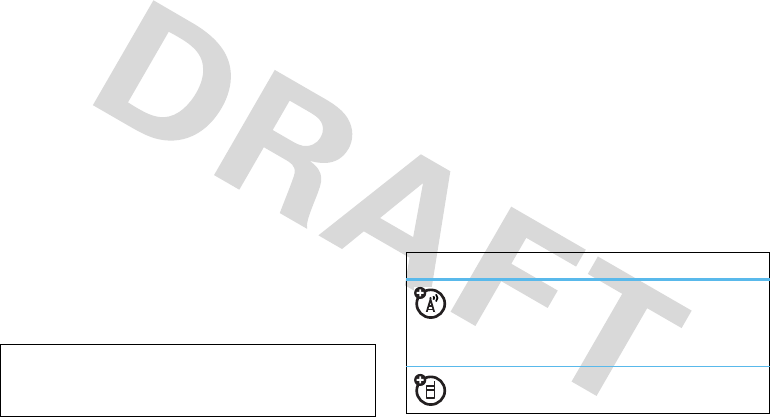
1
HELLOMOTO
congratulations
The
MOTO
Q11™ is a phone with a distinct
edge—personalization, music, videos, and e-mail—all in a
streamlined, intelligent, must-have phone.
The power to multitask is enabled with cutting edge
technology: integrated
WiFi
,
Bluetooth
,
3MP camera
,
HTML browser
,
Docs to Go
to edit your documents, and
more…all in a stylish and ultra-thin design.
We’ve crammed all the main features of your phone into
this handy guide, and in a matter of minutes you’ll see just
how easy your phone is to use. Browse the menus and
press
Menu
to see more. You may be surprised at what you
discover.
So go on, check it out.
more information
If you’d like even more information about how to use your
new
MOTO
Q11™, you can use the following links:
on the Web
Download manuals and more:
www.motorola.com/consumer/support
Microsoft® Windows® Mobile Support:
www.microsoft.com/windowsmobile/help/smartphone/
on the phone
Press
Start
>
1Help and Quickstart
this guide
Caution:
Before using your phone for the first time,
please read the
important legal and safety
information
at the back of this guide (page 50).
symbols in this guide
This means a feature depends on your
network, SIM card, or subscription and may
not be available everywhere. Contact your
service provider for more information.
This means a feature needs an optional
accessory.
2
contents
contents
your phone . . . . . . . . . . . . . . . 3
menu map . . . . . . . . . . . . . . . . 4
get started. . . . . . . . . . . . . . . . 5
home basics . . . . . . . . . . . . . . 8
calls . . . . . . . . . . . . . . . . . . . . . 9
contacts. . . . . . . . . . . . . . . . . 14
messages . . . . . . . . . . . . . . . 16
tips & tricks . . . . . . . . . . . . . . 26
personalize . . . . . . . . . . . . . . . 27
photos . . . . . . . . . . . . . . . . . . 29
videos . . . . . . . . . . . . . . . . . . 31
set up music . . . . . . . . . . . . . 33
get music. . . . . . . . . . . . . . . . 34
play music & media . . . . . . . 35
web browser . . . . . . . . . . . . . 37
Bluetooth® . . . . . . . . . . . . . . 41
synchronize . . . . . . . . . . . . . . 44
WiFi . . . . . . . . . . . . . . . . . . . . 46
tools . . . . . . . . . . . . . . . . . . . . 47
security. . . . . . . . . . . . . . . . . . 47
management . . . . . . . . . . . . . 49
the small stuff . . . . . . . . . . . . 51
3
your phone
your phone
Left Soft Key
Navigate menus.
Select Key
Selects menu
items.
Camera Key
Home Key
Right Soft Key
Microphone
ALT Key
Enter Key
Space Key
Caps Key
Back Key
Power/End Key
Call/Answer Key
Navigation Key
Message/
Display Off Key
Speakerphone/Voice
Recognition Key
Make & answer
calls.
Turn on & off,
hang up, exit
menus.
2.5mm Headset
Jack
Memory Card
Port
Mini USB Port
Charge and
connect phone
accessories
}
Thumb
Wheel
Undo/Back
Key
4
menu map
menu map
To open the menu from the home screen, press
Start
(the left soft key).
&
Messaging
• Text Messages
•MMS
•E-mail
(
Contacts
%
Calendar
g
Internet Explorer
Å
Call History
A
ActiveSync
>
Documents To Go
/
File Manager
2
Games
Ã
Pictures & Videos
y
Personalize My Q
1
Help and QuickStart
$
Ta s k s
-
Accessories
]
Bluetooth
)
Settings
• Phone
• Sounds
• Profiles
• Home Screen
•Clock & Alarm
• Connections
• Security
• Remove Programs
• Power Management
• Accessibility
• Regional Settings
• Owner Information
• About
• Error Reporting
• TTY Settings
• Text Input Settings
• Unread Message Alert
• Phone Information
[
Media Center
c
Windows Media
* Network Dependent
This is the standard main menu layout.
Your phone’s
menu may be different
.
W
Messenger
3
Speed Dial
Ä
Voice Notes
\
Voice Recognition
9
System Tools
Â
Internet Sharing
7
Windows Live
?
Debug Apps
Call Manager
Clock & Alarm
FlashLight
Games and Apps
Getting Started
@
Instant Messenger
Ã
Camera and Album
5
get started
get started
let’s get you up and running
assemble & charge
Caution:
See page 50 for battery use & safety information.
123
7
46
4
H
removing battery
5microSD
SIM
removing microSD
6
get started
check out your storage card
Find it:
Start
>
File Manager
>
Storage Card
While your phone is charging, why not check out all the
cool content on the microSD storage card supplied with
your phone? The supplied content includes
GPS
,
WiFi
and
Social Networking
applications, to help you make the
most of your new phone.
To install the applications
, simply follow the on-screen
instructions.
Tip:
When installing the applications, a Windows prompt
will ask where you wish to save the applications. To
maximize the performance of your phone, it is highly
recommended that you save to the storage card.
You can use your microSD storage card (up to 32 GB) to
store more content, such as data, music, photos and video
clips.
turn it on & off
Press and hold
P
for a few seconds
to turn the phone on/off.
menu navigation
Press
Start
(left soft key) to open your
recently used programs.
Press
All Programs
to display all main
menu items.
Press the navigation key
S
up,
down, left or right to highlight a menu
option.
Tip:
When a menu list is alphabetized,
press its alphabet key to select it.
Press
s
to select the highlighted
option.
In certain screens press
Menu
(right
soft key) to show the menu options.
X
7
get started
basic navigation keys
Note:
Your phone has a further three customizable keys at
the bottom of the keyboard. These keys are instantly
recognizable by the circle icon markers.
make a call
Enter a number from the home screen
and press
N
.
answer a call
When your phone rings or vibrates,
press
N
or
Answer
.
end a call
Press
P
.
adjust volume
You can adjust the volume during a call by pressing the up
or down volume keys on the side of the phone (see
page 3). To mute a call, press
Mute
.
save a contact
1
Enter the number on the home screen and press
Save
.
2
Select whether to save it on your phone (
Outlook Contact
)
or
on your SIM card (
SIM Contact
), enter the contact details
and press
Save
again.
call a contact
1
Press
Start
>
Contacts
.
2
Scroll through the list to highlight the contact.
3
Press
N
.
Home Key
Power/
End
Key
Undo/
Back
Key
Call
Key
Right Soft
Key
Left Soft
Key
Navigation
& Select Key
Fn
Fn
X
8
home basics
transfer your contacts
To transfer your contacts from your old phone to your new
MOTO
Q11™, simply save all your contacts to your SIM
card on your old phone. When you put the SIM card into
your new
MOTO
Q11™, the contacts will all be in your
contacts list.
Note:
SIM contacts only let you store basic information
such as name and number. Other details may be lost and
multiple numbers may be stored as multiple contacts.
set up and go
Read how to set up all the most important features on your
phone, using the
Getting Started
application.
Find it:
Start
>
Getting Started
You can learn how to:
•
Set the date and time.
•
Set up your e-mail.
•
Set up your phone password.
•
As well as learning how to set a cool background and
ring tone.
home basics
a few home truths
The home screen appears when you turn on the phone.
Press
X
to return to the home screen at any time.
Note:
Your home screen may look different to this one.
Press
S
right/left to scroll through the application
shortcuts and press
S
down/up to scroll through the
status fields. Press
s
to select an item.
Start
Home Service
Text Messages (0)
No upcoming appointments.
Profile: Normal
12:00 PM
07/27/08
Contacts
Recent programs
Status reminders
Press to open the Start menu
9
calls
status indicators
Status indicators can appear at the top of the home screen:
calls
it’s good to talk
For the basics, see page 7.
Now do some clever stuff:
recent calls
Your phone keeps lists of your recent calls, even if they
didn’t connect.
Find it:
Start
>
Call History
To call an entry, highlight it and press
N
.
To
send a message
to an entry, highlight it and press
Menu
>
Send Text Message
.
To
filter
your recent calls, press
Menu
>
Missed Calls
,
Incoming Calls
or
Outgoing Calls
.
You can also press
Menu
to
E-mail
,
Delete
or
Save
the entry.
redial a number
1
From the home screen, press
N
to see a list of
recently dialed calls.
2
Scroll to the entry you want to call and press
N
.
w
New voicemail.
C
New message.
E
Bluetooth™ connected.
D
Call forwarding is on.
G
f
)
\
Network connection:
•
G
roaming
•
f
home GPRS
•
)
roaming GPRS
•
\
EDGE (faster connection)
H
I
Your active line - if you’ve got more than
one.
Q
<
Current ring style -
Q
(
Silent
),
<
(
Vibrate
), none
(
Normal
,
Outdoor
, or
Automatic
).
%
Speakerphone is on.
J
Battery level.
0
Signal strength.
10
calls
return a missed call
If you miss a call, your phone will alert you on the home
screen. To return your missed call/s:
1
Scroll to
Missed calls
on the home screen and press
s
.
2
Scroll to the number and press
N
to call it, or press
s
to view the missed call details.
go handsfree
You can use your phone’s handsfree speaker on calls
without holding the phone to your ear.
Note:
The handsfree speaker won’t work when your phone
is connected to a car kit or headset.
During a call, press
h
to turn the handsfree speaker
on/off. A
%
at the top of your display indicates the speaker
is on.
Note:
With a Bluetooth® headset connected, press
Menu
>
Handsfree On
or
Off.
You can also use an optional 3.5mm
wired headset to go handsfree.
features
set auto answer
Set how quickly calls are automatically answered
during hands-free operation:
Start
>
Settings
>
Phone
>
Auto Answer
Note:
These settings do not apply when the ring type is
set to
Silent
.
change volume
Press the side volume keys to change the headset
volume during a call.

11
calls
in-call menu
During a call you can access the in-call menu by pressing
Menu
:
•
Hold
or
Unhold
- hold the call.
•
Mute
or
Unmute
- silence your microphone.
•
Spkrphone On
or
Off
- turn speakerphone on or off.
•
Conference
- join your calls in a conference call.
•
Record
or
Stop Recording
- record your conversation.
•
Contacts
- access list of contacts.
•
View Contact
- view the contact details.
•
View Calendar
- access your calendar events.
•
Call History
- access recent calls.
three-way calling
While connected to a call:
1
Place your current call on hold by pressing
N
.
2
Enter the number of the other person you wish to
connect to a three-way call and press
N
.
3
Once you are connected to the other person, you can
press
Swap
to switch between the calls, or press
Menu
>
Conference
to combine them.
If you
receive a second call
while you are already on a call:
•
To answer the second call and put the first call on hold,
press
Answer
. Then, you can press
Swap
to switch
between the calls, or press
Menu
>
Conference
to combine
them.
•
To send the second call to your voicemail, press
Ignore
.
speed dial
You can use speed dialing in two ways - speed dialing for
up to 98 phone numbers and quick access shortcuts to
main menu items.
To use speed dial entries, press and hold the single-digit
speed dial number. If the speed dial is two digits, press the
first digit, then press and hold the second digit. Your phone
will dial the number or open the feature.
phone numbers
1
Press
Start
>
Contacts
.
2
Scroll to the contact you want a speed dial for and
press
s
.
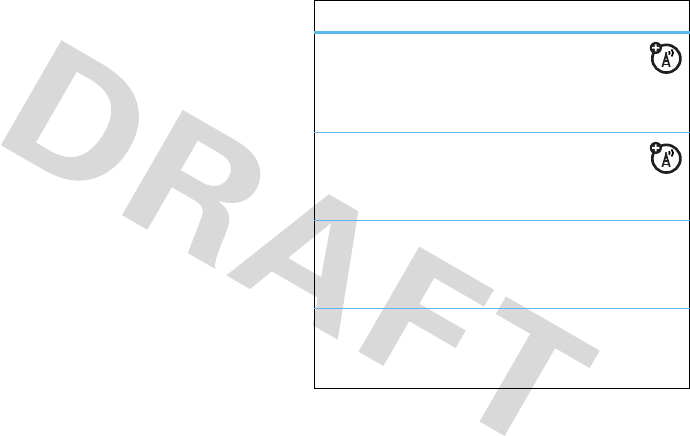
12
calls
3
Scroll to the phone number or e-mail address.
4
Press
Menu
>
Add to Speed Dial.
5
In
Keypad Assignment
, select the speed dial number to use.
Note:
Speed dial 1 is reserved for calling your
voicemail.
6
Press
Done
.
To
delete
a speed dial entry, press
Start
>
Speed Dial
, scroll to
the entry, then press
Menu
>
Delete
.
menu shortcuts
1
Press
Start
.
2
Highlight the application you want a shortcut for and
press
Menu
>
Add Speed Dial
.
3
In
Keypad Assignment
, select the shortcut number to use.
4
Press
Done
.
Note:
To delete a shortcut, press
Start
>
Speed Dial
, scroll to
the shortcut, then press
Menu
>
Delete
. Your service provider
might add a
Voicemail
shortcut you cannot delete.
more call features
features
make international calls
Press and hold
0
to insert the international
access code (shown as
+
). Then, press the keypad keys
to dial the country code and phone number.
set answer options
Answer a call by pressing any key:
Press
Start
>
Settings
>
Phone
>
Call Options
>
Any Key Answer
forward calls
Forward calls to another number:
Press
Start
>
Settings
>
Phone
>
Call Forwarding
silence ringtone
When your phone rings, press the side volume keys to
silence your ringtone.
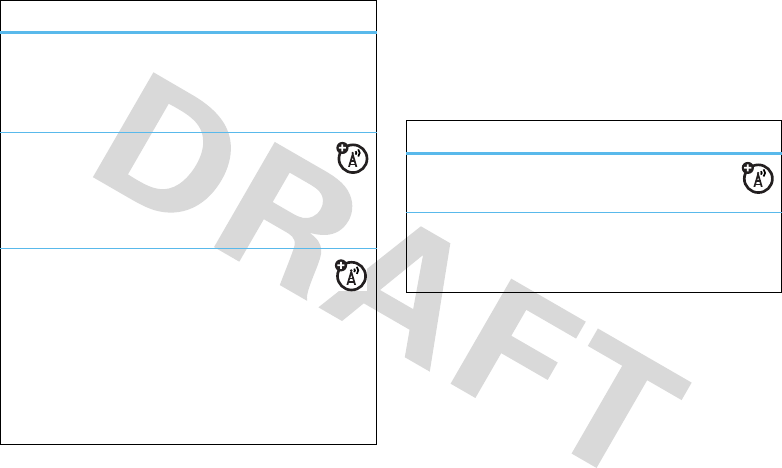
13
calls
call times and costs
These features give you a rough idea of how much call time
you’ve used and the cost. Note that these figures may not
match what your service provider charges you, as they’re
not measured in the same way.
emergency calls
To call an emergency number, enter the emergency
number and press
N
.
Your service provider programs emergency phone numbers
(such as 112 or 911) that you can call under any
circumstances, even when your phone is locked.
Emergency numbers vary by country. Your phone’s
pre-programmed emergency number(s) may not work in all
voice dial
To voice dial, press and hold
h
in your home screen.
When prompted, say “Call”, then wait for the prompt and
clealry say the number or contact name.
restrict calls
Restrict outgoing or incoming calls:
Press
Start
>
Settings
>
Phone
>
Call Barring
Select which incoming and outgoing calls to block.
TTY calls
Set up your phone for use with an optional TTY
device:
Press
Start
>
Settings
>
TTY Settings
Note:
A teletypewriter (TTY) is a communication device
used by people who are hard of hearing or have a
speech impairment. TTY does not work from one mobile
device to another.
features
features
view call timersr
Press
Start
>
Call History
then press
Menu
>
View Timers
reset call timers
Press
Start
>
Call History
then press
Menu
>
View Timers
, then
press
Menu
>
Reset Timers

14
contacts
locations, and sometimes an emergency call cannot be
placed due to network, environmental, or interference
issues.
AGPS & emergency calls
When you make an emergency call, your phone can
use Assisted Global Positioning System (AGPS)
satellite signals to tell the emergency response
center your approximate location.
AGPS has limitations, so always tell the emergency
response center your best knowledge of your location.
Remain on the phone for as long as the emergency
response center instructs you.
AGPS
might not work
for emergency calls if your local
emergency response center does not process AGPS
location information. For details, contact your local
authorities.
Your phone can also use your location to help with other
features (such as those that provide directions).
contacts
made a new friend?
For the basics see page 7.
SIM contacts, phone contacts
To create a new contact stored on your SIM card:
Find it:
Start
>
Contacts
>
New
>
SIM Contact
To create a new contact stored on your phone:
Find it:
Start
>
Contacts
>
New
>
Outlook Contact
edit or delete a contact
1
Press
Start
>
Contacts
. Scroll to the contact.
2
Press
Menu > Edit
or
Delete Contact
.
send a message to a contact
1
Press
Start
>
Contacts
. Scroll to the contact.
2
Press
Menu > Send Contact > Text Message
.
15
contacts
store more than a number
Your clever phone can store more than just a number for a
contact.
1
Create a new contact stored on your phone. Press
Start
>
Contacts
>
New
>
Outlook Contact
.
2
Use the fields to enter details:
•
Name & Numbers: Store multiple numbers such
as home, work and mobile.
•
E-mail: Store e-mail addresses.
•
Address: Store postal addresses.
•
Picture: Add a photo so you can see who’s calling
you.
•
Custom ring tone: Set a unique ringtone and
message alert so you can hear who’s calling you.
•
Others: Add birthday, nickname and other details.
3
Press
Done
to save the contact.
more contacts features
features
search for contact
Enter the first few letters of the contact's name. Your
phone searches through the contacts list and shows the
name.
set category for contact
Note:
You cannot store a category for SIM Contacts.
Press
Start
>
Contacts
, scroll to a contact, then press
Menu
>
Edit
>
Categories
filter categories
Press
Start
>
Contacts
, then press
Menu
>
Filter
16
messages
messages
sometimes it’s better 2 say it in a message
You can send and receive three types of messages using
the
Messaging
feature: SMS (text messages), MMS
(multimedia messages), and e-mail messages. To set up
e-mail on your
MOTO
Q11™, see page 18. If you have
problems setting up e-mail or synchronizing, please visit
www.motorola.com/consumer/support
.
send a message
Find it:
Start
>
Messaging
1
Select the message type -
Text Messages
,
MMS
or
E-mail
.
2
Press
Menu
>
New
.
3
For e-mail, in
To
,
Cc
, and/or
Bcc
, enter e-mail addresses
or names from your Outlook contacts (as you enter a
contact name, suggestions appear in a box below the
To
field). Insert a semicolon (;) between multiple
numbers or addresses.
For text messages, enter a phone number or contact
name. As you enter a contact name, suggestions
appear in a box below the
To
field.
send contact to another device
Use a Bluetooth® connection to send a contact to
another phone, computer, or device:
Turn Bluetooth on
- press
Start
>
Bluetooth
>
Bluetooth
Manager
>
Filter
>
Status
>
Bluetooth On
.
Send the contact
- press
Start
>
Contacts
, scroll to a
contact, and press
Menu
>
Send via Bluetooth
.
Your phone searches for other Bluetooth devices. Select
the one you want and you will be told when the transfer
is complete.
For more about Bluetooth connections, see page 40.
features

17
messages
Tip:
You can quickly enter phone numbers or e-mail
addresses from your contacts. In
To
, press
j
and
select a recipient from the list. Then select the
recipient's phone number or e-mail address.
4
Use the keypad to enter a message:
To i n s e r t
a picture, video, voice note or file in an MMS
or e-mail message, press
Menu
>
Insert
.
To set message options
, press
Menu
>
Options
.
To c a n c e l
a message, press
Menu
>
Cancel Message
.
5
Press
Send
.
receive & read messages
When you receive a message your phone plays an
alert and shows a message indicator, such as
C
.
To read a message:
on the Home Screen, press the
navigation key
S
to scroll to the message notification
area and press the center key
s
to open the message
type.
When you have a message open
, you can enter a
response below the message text. To copy/paste message
text or choose other options, press
Menu
.
To access all your messages at any time from the menu,
press
Start
>
Messaging
>
Text Messages
, email account or
MMS
.
Tip:
Want to switch inboxes quickly? Press the
navigation key
S
left or right to jump from one inbox to
another.
message attachments
Yo u c a n
send
,
read
, and
receive
PDF, ZIP,
Microsoft® Word, Excel, and PowerPoint files attached to
e-mail.
You can edit all Microsoft files on your phone
,
but you can only view other files such as PDF and ZIP.
To
download
the attachment, select the file and follow the
prompts to open it. When the document opens, you can
move around the page using the navigation key
S
.
•
Excel spreadsheets: Select cells and enter numbers or
text. Press
Menu
for options like save, cut, copy, paste,
find, delete, and more.
•
PowerPoint slide shows: Press the left softkey to
switch between notes, outline and slide views.
Press
Menu
for options like save, cut, copy, paste, find,
delete, and more.

18
messages
•
Word documents: Type numbers or text into the
document. Press
Menu
for options like save, cut, copy,
paste, find, delete, and more.
To
transfer
attachments to your computer for editing, use
Microsoft® ActiveSync, see page 43 for more information.
message options
To delete, save, reply, or forward the messages, use these
quick steps from the Inbox with a message selected or
when viewing a message:
•
To delete, press
Delete
. To delete multiple messages in a
row, scroll to the top message you want to delete,
then select
Menu
>
Select Messages
>
All
,
All Below
,or
Several
,
and then press
Delete
.
•
To reply, press
Menu
>
Reply
>
Reply
or
Reply All
. Enter the
message and press
Send
.
•
To forward, press
Menu
>
Reply
>
Forward
. Enter the
message and press
Send
.
•
To save the sender in your Contacts, highlight the
sender and press the center key
s
>
Save
.
Tip:
Need to get the latest status on your e-mail inbox?
Press
Start
>
Messaging
. Select the account to send and
receive messages and press
Menu
>
Send/Receive
. The phone
connects to your Internet e-mail server and sends and
receives your messages. To stop this process, press
Menu
>
Stop Send/Receive
.
set up e-mail
if you’ve got an MSN or Hotmail e-mail account:
1
Press
Start
>
Windows Live
>
Sign in to Windows Live
.
Note:
If your network service provider does not offer
Windows Live
, use the
set up standard e-mail
procedure
below.
2
Enter your e-mail address and password, then
press
Next
.
3
Choose the options you want, then press
Next
.
4
When synchronization is complete, press
Done
.
if you’ve got a standard personal e-mail account
(like Yahoo or Gmail):
1
Press
Start
>
Messaging
>
Setup E-mail
.
2
Enter your e-mail user name and password, then
press
Next
. Your phone tries to retrieve your account
settings from your e-mail provider.
If your phone finds
your account settings, it tells you.
You just have to press
Next
.
19
messages
If your phone doesn’t find
your account settings, it
gives you a chance to enter them. To get this
information, contact your e-mail provider.
3
Enter your name (the messages you send will show up
as “From” this name), then press
Next
.
4
Choose how often you want your phone to check for
new e-mail, then press
Finish
.
Note:
E-mail service depends on your e-mail and phone
network service providers. If you have problems setting up
e-mail or synchronizing, please visit
www.motorola.com/consumer/support
.
if you’ve got a work e-mail account
Note:
To get the information requested in these steps,
contact your company’s system administrator.
1
Press
Start
>
ActiveSync
, then press
Menu
>
Add Server Source
.
2
Enter your e-mail address and check
Attempt to detect
Exchange Server settings automatically
, then press
Next
.
3
Enter your
User Name
,
Password
, and the server’s
Domain
,
then press
Next
.
If your phone finds
your server settings, it tells you.
You just have to press
Next
.
If your phone doesn’t find
your server settings, or if
you skip the automatic detection, you can enter the
settings provided by your company’s system
administrator: Enter the Exchange
Server Address
(if
necessary, check
This server requires an encrypted (SSL) connection
),
then press
Next
.
4
Choose if you want to synchronize
Contacts
,
Calendar
,
Email
,
and
Tasks
, then press
Finish
.
5
Press
Sync
to synchronize with the Exchange server.
messaging shortcuts
If speed is what you need, press the following keys to do
things quickly when you have an Inbox open. Press and
hold the keys if you have a message open:
key function
0
list shortcuts
1
reply all
2
reply
3
mark read or unread
5
move
6
forward
20
messages
messaging quick reference
Note:
Some features might not work if you set up
your e-mail account manually (without the e-mail
setup wizard).
7
(D
)
delete
8
download message
9
send/receive
features
send text message
Press
Start
>
Messaging
>
Text Messages
>
Menu
>
New
key function
create and send e-mail
Press
Start
>
Messaging
> e-mail account >
Menu
>
New
Note:
You need to have your e-mail set up to send
an e-mail (see page 18 for more information).
To add a picture, voice note, or file to an e-mail
message, open the message area and press
Menu
>
Insert
>
Picture
,
Voice Note
,or
File
.
Tip:
You can save a draft of a message that you are
composing to finish and send later. Press
Menu
>
Save
to Drafts
. A draft of the message is stored in the Drafts
folder of the account you are in.
features
21
messages
create and add an e-mail signature
Press
Start
>
Messaging
> e-mail account
>
Menu
>
Tools
>
Options
>
Signatures
Scroll to the account for which you are creating the
signature. Select
Use signature with this account
. Scroll to
the
Signature
box, enter your signature, and press
Done
.
Tip:
To insert a signature in every message you
send, select
Include when replying and forwarding
. Otherwise,
a signature is inserted only in new messages.
read new messages
To quickly view new messages, select the
message notification area on the home screen.
view attachment
While viewing the message, use the
center key
s
to select the attachment.
Note:
You can view attachments only for file types
that are supported by the device.
features
read old e-mails
Press
Start
>
Messaging
> e-mail account
Icons next to each message show if it is
unread
J
,
read
H
,
urgent
K
, or has an
attachment
R
.
reply, reply all or forward emails
From your Inbox or an open message, press
Menu
>
Reply
>
Reply
,
Reply All
, or
Forward
Tip:
If you are replying to an e-mail in the e-mail
account, you will send less data if you do not edit
the original message. This may reduce data transfer
costs based on your rate plan.
features

22
messages
download message objects
If an e-mail message includes an
attachment, when you open the message,
the name of the attachment will appear
highlighted. To download the attachment, select the
highlighted attachment name. The attachment is
downloaded the next time you synchronize or
connect to your e-mail server.
Note:
If there are multiple attachments in the
message, only the selected attachments are
downloaded.
insert a media object in an e-mail
To add a picture, voice note, or file in an e-mail
message, in the composing message area press
Menu
>
Insert
>
Picture
,
Voice Note
or
File
.
features
download complete e-mail messages
Press
Start
>
Messaging
> e-mail account. Scroll
to the message and press
Menu
>
Download
Message
.
The complete message is retrieved the next time
you synchronize or connect to your e-mail server
and send and receive e-mail.
features
23
messages
mark a folder for synchronization
When you synchronize your e-mail account
with your PC, the same Inbox folders that are in
Outlook on your PC are created on your phone.
Press
Start
>
Messaging
> e-mail account >
Menu
>
Folders
>
Menu
>
Show all Folders
>
Menu
>
Manage Folders
.
Highlight each folder you want to synchronize and
press
Sync
.
Once all folders have been selected, press
Done
. This
opens the
Manage Folders
view, where the marked
folders will be synchronized during the next sync
session.
Note:
Only e-mail folders stored on the server are
available for sync.
view status of sent e-mail
Press
Start
>
Messaging
> e-mail account >
Menu
>
Folders
>
Outbox
Messages in the
Outbox
have not been sent. To send
a message, scroll to it and press
Menu
>
Send/Receive
.
features
receive e-mail
If your phone is set up to automatically
check for new messages, your phone will show
e
when a new message arrives.
Press
R
to open the Inbox.
delete e-mail
From the Inbox or an open e-mail message, press
Menu
>
Delete
.
manually send and receive e-mail
Press
Start
>
Messaging
> e-mail account >
Menu
>
Send/Receive
.
call a phone number in e-mail
Highlight a phone number in a message and
press
N
.
move e-mail to personal folder
After you read the e-mail, press
Menu
>
Move
> folder.
features
24
messages
instant messager
Find it:
Start
>
Instant Messager
Connect to your favourite online instant messaging
community with effortless ease.
Follow the prompts to sign into an account. For more
details, visit
get.live.com/wl/all
.
Tip:
Set your preferences to make your messaging
experience even more enjoyable: press
Menu
>
Communities
. Or,
change the community you are linking to: press
Menu
>
Communities
.
text entry
You can enter text and numbers using the keypad. When
you select a field that requires text or numbers, the phone
automatically selects the appropriate entry mode. An
indicator at the top right of the display shows the entry
mode you are currently using.
delete a mail account
Press
Start
>
Messaging
, scroll to the e-mail account,
then press
Menu
>
Delete
.
Note:
You cannot delete your
Text Messages
,
MMS
, or
Exchange server e-mail accounts.
empty deleted items folder
Press
Start
>
Messaging
> e-mail account >
Menu
>
Folders
,
scroll to
Deleted items
, then press
Menu
>
Delete All
.
features
Press
Menu
to open the
sub-menu.
Press
H
to switch entry modes. For indicator
descriptions, see the following section.
Send
Text Messages
To:
0/160
Menu
25
messages
Press
H
in a text entry
view to select an entry
mode:
•
To
delete
one character, press
o
. Hold
o
to keep
deleting.
•
To start a new line, press
j
.
•
To enter the number or character above the letter on
each key, press the Alt key
H
.
text prediction
As you enter letters, your phone might try to
predict
the
word. For instance, it might predict “program” when you
enter “prog”.
To accept the prediction, scroll to the predicted word and
press the center key
s
. To enter a space after your word,
press
f
. To turn off text prediction, press
Start
>
Settings
>
Text Input Settings
and uncheck
Suggest Words When Typing
.
voicemail
When you
receive
a voicemail message, your phone
shows an indicator and
New Voicemail
. Press
Call
to call
your voicemail and follow the prompts.
entry modes
i
Enters the alphabetical character on each
key (such as
Q
).
To enter capital letters
, press
k
to
switch to all capitals (
á
), no capitals
(
Á
), or one capital (
Â
).
Ã
Enters the number or character on the
next key pressed (such as
!
), then returns
to the previous text entry mode.
Ä
Enters the number or character on the
keys until you press
H
again.
Your phone automatically chooses
Ä
for
entries that only allow numbers, like phone
numbers.
26
tips & tricks
tips & tricks
a few ways to make your phone even easier to use
From the home screen, use these shortcuts:
To... Do this...
lock keypad
Press
X
, then
f
.
use most
recently used
feature
Icons for your most recently used
features appear across the top of the
home screen. Use the navigation keys
to select one.
open recent
calls
Press
N
. To return a call, use the
navigation key to scroll to the call, then
press
N
.
open your
messages and
browser
Use shortcut keys to access your
messages
R
, and Web
browser
T
.
use memo
pad
Jot down and retrieve quick notes on
the memo pad (great when you’re on
the run):
Start
>
Accessories
>
Memopad
.
open quick
options
Press and hold
X
.
play music or
games on an
airplane
To keep using your games and music
on a flight, turn off your network and
Bluetooth® services. Press and
hold
X
until the quick list appears,
then select
Wireless Manager
>
All
.
access
voicemail
Press and hold
1
.
To... Do this...
27
personalize
personalize
not just any clever phone, make it your clever phone
home screen
Set a photo or picture as a wallpaper (background) image or
change your layout and color scheme on your home screen.
Find it:
Start
>
Settings
>
Home Screen
profiles & sounds
For incoming calls and other events, use
Profiles
to set ring
styles and volume settings and use
Sounds
to change the
sounds played (ring tones, etc.).
To select a profile:
Find it:
On the home screen, press and hold
X
> profile
style name >
s
You can select and edit
Normal
,
Silent
,
Vibrate
,
Outdoor
and
Automatic
profiles.
Note:
The
Automatic
profile is the same as
Normal
, except that
it automatically switches to
Vibrate
during any event stored in
your Calendar.
To edit a profile:
Find it:
Start
>
Settings
>
Profiles
> profile style name >
Menu
>
Edit
To change sounds:
Find it:
Start
>
Settings
>
Sounds
time & date
Find it:
Start
>
Clock & Alarm
>
Date and Time
options
Home Screen
Layout
Select a layout for the home screen.
Color Scheme
Select a color scheme for the display.
Background
Image
Select a picture for your wallpaper
image.
Time out
Select the time interval before the
display returns to the home screen, or
Never
.
28
personalize
You can specify the date and time style by changing the
regional settings: press
Start
>
Settings
>
Regional Settings
.
personalize my Q
Find it:
Start
>
Personalize My Q
Edit all the most important customizing features on your
phone, such as homescreen and sound settings.
task manager
Find it:
On the home screen, press and hold
X
to open
the quick options menu, then select
Task Manager
.
Want to see what programs are active on your phone?
Tip:
Need to stop running a program? In
Task Manager
, select a
program and press
End Task
.
Note:
If you want to completely remove a program from
your phone, from the home screen, press
Start
>
Settings
>
Remove Programs
.
more personalizing
features
set backlight
Set the backlight timeout to save battery life:
Press
Start
>
Settings
>
Power Management
>
Backlight time out
on battery
change language
Set menu language:
Press
Start
>
Settings
>
Regional Settings
>
Language
Note:
You need to turn your phone off and on again
for the changes to take effect.
accessibility
Set system font size, multipress timeout,
confirmation timeout, and in-call alerts:
Press
Start
>
Settings
>
Accessibility
29
photos
photos
see it, capture it, send it!
take a photo
Press
Start
>
Pictures & Videos
>
Camera
to see the camera
viewfinder and then press
s
to take the photo.
Tip:
In the camera viewfinder, press
Menu
to adjust picture
settings such as
mode
,
resolution
,
zoom
,
white balance
,
and
flash
.
Once you’ve taken your photo, press
Camera
to save the
photo and return to the viewfinder, or press
Menu
to
Send
the
photo or
Delete
it.
save owner information
Think of it as your phone’s identity tag.
Enter owner information to help someone return
the phone to you if you lose it:
Press
Start
>
Settings
>
Owner Information
reset settings
To return your phone to original settings, press
Start
>
System Tools
>
Master Reset
The default master reset code is
000000
(6 zeroes) -
see page 47.
Master reset does not reset the unlock code,
security code, and lifetime timer.
features
Thumbnails
Pictures & Videos
Menu
877 1.0x
IMAGE
AREA
30
photos
Note:
To see your stored pictures, press
Start
>
Pictures &
Videos
, highlight the picture thumbnail and press
View
.
Tip:
To view pictures located in a folder other than the
default pictures folder, including a storage card, press
Start
>
Pictures & Videos
, then press
Menu
>
Folders
, and select the
folder that contains stored pictures.
photo options
In the camera viewfinder press
Menu
>
Options
to open the
Picture Options Menu
. This menu can include:
self portrait
1
Press
Start
>
Pictures & Videos
>
Camera
to activate the
camera.
2
Press
Menu
>
Mode
>
Timer
.
3
Aim the camera lens at yourself and allow for a 5
second delay.
4
When you hear the camera shutter sound, your phone
takes the photo and shows it in the viewfinder.
manage your photos
Find it:
Start
>
Pictures & Videos
>
picture
Press
View
to view a highlighted picture. Press
Menu
to send,
rename, save, edit, delete and more.
edit your photos
Find it:
Start
>
Pictures & Videos
1
Highlight a photo and press
View
to open it.
2
Press
Menu
>
Edit
.
3
From the edit screen, press
Menu
to rotate, crop or auto
correct your photo.
4
Press
Menu
>
Save As
to save your edited photo.
option
General
Determine default picture sizes for
e-mail and rotating picture settings.
Slide Show
Select default slide show settings.
Camera
Select default locations to store
pictures, filename prefixes, and image
compression.
Video
Determine audio settings and time
limits for video files.
31
videos
videos
for those moments when you really had to be there
record a video
Press
Start
>
Pictures & Videos
>
Camera
then
Menu
>
Video
to see the
camera viewfinder. Press
s
to start recording and press
Stop
to stop.
Tip:
In the video viewfinder, press
Menu
to adjust picture
settings such as
brightness
,
quality
, and
white balance
.
Once you’ve taken your video, press
Camera
to save the
video and return to the viewfinder, or press
Menu
to
Send
the
video or
Delete
it.
Note:
To see your stored videos, press
Start
>
Pictures & Videos
,
highlight the video and press
Play
.
Tip:
To view videos located in a folder other than the
default videos folder, including a storage card, press
Start
>
Pictures & Videos
, then press
Menu
>
Folders
, and select the
folder that contains stored videos.
video options
In the video viewfinder press
Menu
>
Options
to open the video
options menu:
00:05 43:20
Stop
Pictures & Videos
Pause
VIDEO
AREA
Remaining recording time Current recording length
option
Camera
Select default save locations, video
filename prefixes, and image
compression.
Video
Determine audio and time limit
settings for video files.
32
videos
play a video clip
Find it:
Start
>
Pictures & Videos
> video clip >
Play
The video clip plays in the
Windows Media Player
.
Tip:
To play video in full screen mode, press
Menu
>
Full Screen
.
Videos recorded in a low resolution may not play in full
screen mode.
If a call comes in while watching a video, the video pauses
and a call alert appears. You can choose to answer the call
or ignore it. To continue watching the movie, press
Play
.
video playback options
In the video playback window, press
Menu
>
Options
to open
the
Video Playback Menu
. This menu can include:
manage your videos
Find it:
Start
>
Pictures & Videos
Press
Play
to view a highlighted video. Press
Menu
to send,
rename, save, edit, delete and more.
00:00 70%
Now Playing
Windows Media
Menu
option
Playback
Determines how the time counter
appears.
Video
Options for showing in full screen and
when to scale to fit window.
Network
Selects default network settings for
streaming media.
Library
Determines if the player starts on the
Library
view.
Skins
Determines the skin theme.
Buttons
Set playback button mapping.

33
set up music
set up music
what you need to start...
what music transfer tools do I need?
To put music on your computer and then load it on your
phone, you need:
•
A Microsoft® Windows® PC
•
A USB data cable (may be
sold separately
)
do I need a storage card?
Your phone does have 64 MB of internal memory but it also
supports removable microSD storage cards with up to
32 GB capacity, allowing you to store much more.
Tip:
To see the available memory on your phone and
storage card, press
Start
>
System Tools
>
Memory Manager
.
what music file formats can I play?
Your phone can play many types of files: MP3, MIDI, AAC,
WAV, WMA, WAX and WMV.
what headphones can I use?
Your phone has a 3.5mm headset jack for wired stereo
listening. Or, go wireless and use optional Bluetooth stereo
headphones to listen to your music.
get music
rip and transfer...
rip a CD
Not literally—if you’re new to music this means transferring
music from a music CD to your PC.
To rip a music CD on your PC, you need Windows Media
Player version 10 or later. You can download Windows
Media Player from
www.microsoft.com
.
1On your computer
, launch Windows Media Player.
2
Insert a music CD into your computer’s CD ROM drive.
Note:
Make sure you change the format to MP3, MIDI,
AAC, WAV, WMA, WAX or WMV in the Rip Settings.
(MP3 is the recommended format for best
performance.)
3
In the Windows Media Player window, click on the
“Rip” tab.
4
Highlight the tracks you want to import and click “Rip
Music“.
The tracks are imported to the Windows Media Player
Library. Next, transfer the tracks from your computer to
your phone.

34
get music
transfer music to your phone
Transfer music files from a computer to your phone or
storage card.
PC to phone
To load music files from a PC
to your phone
, you need a
USB cable.
1
With a storage card inserted and your phone in the
home screen, insert the USB cable in your phone and
your Windows PC.
Note:
Your phone supports Microsoft® Windows®
2000 and Windows XP™. Other operating systems
may not be compatible.
2
Now that you’ve connected, use
Windows Media
Player
or
USB drag and drop
to copy your music.
Windows Media Player
1On your Windows PC
, open Microsoft® Windows®
Media Player 10 or later.
2
On the “Sync” tab, select “More Options”. Under
Device, select your phone.
3
Select “Properties”, check the “Create folder hierarchy
on device” box, and click “OK”.
USB drag & drop
1
Use the “My Computer” window to find “Removable
Device”.
2
Drag and drop your music to your phone folder. To help
manage your music, you can create more folders in
your phone folder.
3
When you’re done, use the “Safely Remove
Hardware” feature to finish.
35
play music & media
play music & media
when music is what you need...
You can play audio and video files that are on your phone or
on the Web.
Your phone has Windows® Media Player Mobile for
Smartphone version 10.2 or higher, which can play the
following types of files: Windows Media Audio (WMA),
Windows Media Video (WMV), MP3, AAC, and WAV.
Find it:
Start
>
Windows Media
music player controls
To customize your controls
:
1
From the media player, press
Menu
>
Options
>
Buttons
.
2
Scroll to the media player action you want to assign a
button or key press, and press
Menu
>
Assign
,
Reset
, or
None
.
3
After you have assigned key presses to the player
controls, press
OK
and
Done
to complete the set up.
00:00 70%
Now Playing
Windows Media
Menu
control
play/
pause
To play or pause a music or video file,
press
j
.
skip ahead or go
back
To skip to the previous or next file, press
the navigation key
S
left or right.
volume
To change the volume, use the side
volume keys or press the
navigation key
S
up or down.
Tip:
To turn the sound off quickly, press
#
. Press
#
to turn the sound back on.
fast forward/
rewind
To fast forward or rewind, press and hold
the navigation key
S
left or right.
36
web browser
To play audio or video files
:
1
From the media player, press
Menu
>
Library
.
2
Select
My Music
,
My Videos
,
My TV
,
My Playlists
, or
Now Playing
.
Tip:
Do you want to play a song or video on the Internet or
network? Use the Open URL command. From the
Library
view, press
Menu
>
Open URL
.
wake up music player
While the music player is active, your phone will conserve
power by turning off the display and keypad backlights.
To turn the display and backlights back on, press any key.
turn off music player
To turn off the music player, press
Menu
>
Stop.
music player tips
If you receive a call while playing music, the music pauses.
Yo u c a n
Ignore
the call and send the caller to voicemail or
Answer
the call. Playing resumes when you end the call.
To hide your music player while a song is playing, simply
navigate to another menu item.
If
the music player is
hidden, you can use other phone features.
To view the song details, press
Menu
>
Properties
.
web browser
you don’t need a PC, surf the web with your phone
Find it:
Start
>
Internet Explorer
Note:
Not all Web file formats are supported.
•
To go to a Web page, press
Menu
>
Address Bar
. Enter the
address and press
Go
.
•
To go to a link in a Web page, highlight the link and
press the select key (
s
).
•
To change connection options, press
Menu
>
Tools
>
Options
>
Connections
.
•
To show/hide pictures, press
Menu
>
View
>
Show Pictures
.
Zoom Out
file://\windows\default.htm
History
Menu
h
Internet Explorer Mobile
Microsoft®
Favorites
ä
>> >>
>
37
web browser
•
To add a Favorite, open the Web page and press
Menu
>
Add to Favorites
.
browser shortcuts
Use shortcut keys for browsing the Web:
Note:
If you’re not set up for internet access, contact your
service provider for settings.
third-party applications
Third-party applications, or add-on programs, can include
e-mail, security, mobile office, and productivity software.
These products can typically be downloaded and installed
immediately. Compatible commercial and free applications
are available on the Internet.
To
purchase and download
applications (programs) and
games for your phone. Go to:
http://www.motorola.com/support/Q-gsm
and click on “Application
Catalog” or visit
http://www.handango.com
.
Warning:
Downloading and installing numerous third-party
applications can negatively affect memory usage and the
performance of the phone. Proceed with moderation.
Note:
Applications written for previously released devices
or older versions of Windows Mobile may not function
reliably on this phone. Contact the application provider to
check compatibility before installing the application on this
device.
Internet Sharing
You can use your phone to dial in to a network (similar to
Dial Up Networking or DUN). To do this, you need either a
Bluetooth wireless or USB cable connection.
Find it:
Start
>
Internet Sharing
On your computer, you must have installed ActiveSync 4.5
or later or Windows Mobile Device Center on Windows
Vista™, and have enabled a Personal Area Network (PAN)
server.
Note:
When you activate Internet Sharing, your phone’s
e-mail, Web browsing, Microsoft® ActiveSync or
Windows® Mobile Device Center, and text messaging
key function
U
page up
D
page down
T
go to the top of the page
B
go to the bottom of the page
F
Switch to full screen or normal view.

38
web browser
services are suspended until you deactivate
Internet Sharing.
Internet Sharing with Bluetooth wireless
To use Bluetooth wireless to link to a network:
Note:
You must have a computer that has
Bluetooth capabilities for Internet Sharing to work with
Bluetooth wireless.
1
To make sure other Bluetooth devices can find your
phone, you must first turn on Bluetooth wireless.
On
your phone
, press
Start
>
Bluetooth
>
Bluetooth Manager
>
Settings
then toggle
Status
to
Bluetooth ON
. See page 62 for
more information.
2On your computer
, launch the Bluetooth devices
applet from the task bar.
3
On your computer, right-click the Bluetooth icon in the
Windows task bar, select the
Quick Connect
>
Dial-up Networking
>
Find devices
. The computer
finds your phone and shows the dial up networking
window.
Note:
Not all computers have the same procedure to
locate the Bluetooth window and set up networking.
Please refer to your computer operating help system
for more information.
4On your phone
, press
Start
>
Internet Sharing
.
5
Set
PC Connection
to
Bluetooth PAN
and click
Connect
.
The
Status
changes to
Connected
.
6
Press
Menu
>
Bluetooth Settings
and select
Personal Network
.
7
When you see the name of your computer in the list of
personal networks, select it and press
Add
to establish
a connection.
Internet Sharing with a cable
Note: Do not connect
your data cable to your phone and
computer until the following steps tell you to do so.
On your phone:
Enable Internet Sharing on your phone and install phone
drivers:
1
On your phone, press
Start
>
Settings
>
Connections
to set up
the GPRS and Proxy information as specified by your
service provider. These settings are the same as for
connecting to the internet.

39
web browser
2
Using the USB data cable, connect the phone to your
computer.
The driver is installed on your computer and ready for
setting up a network connection.
3On your phone
, press
Start
>
Internet Sharing
.
4
Set
PC Connection
to
USB
and click
Connect
. The
Status
changes
to
Connected
.
On your computer:
After you set up your computer and phone, you can
establish a new network connection on your computer:
Note:
This procedure might not work on all computers.
Please refer to your computer operating help system for
more information.
5
Right-click on
My Computer
and select
Properties
>
Hardware
tab.
6
Press the
Device Manager
button and expand the
Modems
list.
7
Right-click
Smartphone Wireless USB Modem
and
select
Properties
.
8
Select the
Advanced
tab, and enter extra initialization
commands required by your service provider. For
details, contact your service provider.
9
Open the Network Connections window. On some
computers, you select
Start
>
Control Panel
>
Network and Internet Connections
>
Network
Connections
. Your computer might be a little different.
10
In the Network Connections window, select
Create a
new connection
under Network Tasks.
11
Follow the prompts to connect to the Internet using a
modem:
•
Network Connection Type:
Connect to the Internet
•
Getting Ready:
Set up My Connection Manually
•
Internet Connection:
Connect using a dial-up modem
•
Connection Name: Enter a unique identifier for ISP
name.
•
Number to Dial:
*99#
•
Connection Availability:
Anyone's Use
•
User Name: get this information from your service
provider as required

40
Bluetooth®
•
Password: get this information from your service
provider as required
•
If you do not plan to use your phone as the default
Internet connection, then
do not
check
Make this the
default Internet connection
.
•
If Microsoft® Windows® firewall is not enabled,
do not
check
Turn on Internet connection firewall for this
connection
.
Note:
You might need to deactivate your computer
proxy server settings to let Internet Sharing access the
Internet. To do this, open your Web browser and select
Menu
>
Tools
>
Internet Options
>
Connections
>
Settings
>
Proxy
Server
, then deselect
Use a proxy server for this connection
).
disconnect Internet Sharing
On your computer
:
1
Go to task bar and right-click on the Network
Connection icon.
2
Select
Disconnect
.
Your computer disconnects Internet Sharing.
Note:
After you are no longer using Internet Sharing, you
may need to reactivate your computer’s proxy settings.
Please check with your Internet provider.
Bluetooth®
lose the wires and go wireless
Your phone supports Bluetooth wireless connections. You
can connect your phone with a Bluetooth audio device,
such as a handsfree headset or music system. You can also
connect your phone with a phone or computer that
supports Bluetooth connections to share files.
Note:
Using a mobile phone while driving may cause
distraction. End a call if you can’t concentrate on driving.
Also, using a mobile or accessory may be prohibited or
restricted in certain places. Always obey the laws and
regulations on the use of these products.
For maximum Bluetooth security
, you should always
connect Bluetooth devices in a safe, private environment.
turn Bluetooth power on or off
If Bluetooth
Power
is
On
, your phone can automatically pair
with the Bluetooth device you have used before. Just turn
on the Bluetooth device or move it near your phone.
To turn on Bluetooth power: Press
Start
>
Bluetooth
>
Bluetooth
Manager
>
Settings
then toggle
Status
to
Bluetooth ON
.
The Bluetooth indicator
O
appears in the home screen.

41
Bluetooth®
Note:
To extend battery life, use the previous procedure to
set Bluetooth
Power
to
OFF
when not in use. Your phone will
not pair with devices until you set Bluetooth
Power
back to
ON
and pair your phone with the Bluetooth devices again.
pair with a headset or handsfree device
Before you try to pair your phone with a headset or
handsfree device
, make sure your phone’s Bluetooth
power is
on
and the Bluetooth device is
on
and
ready
in
pairing or bonding mode (see the Bluetooth device user’s
guide). You can pair your phone with multiple other devices,
but only use it with one headset at a time.
Your phone lists the Bluetooth devices it finds within range.
1
Press
Start
>
Bluetooth
>
Bluetooth Manager
>
Hands-free
.
2
Put the handsfree headset, stereo headset, keyboard,
etc. in pairing mode.
3
Press
Add
. Your phone prompts you to verify the
Bluetooth device is ready. Press
Search
.
4
Select the Bluetooth device from the list.
5
If prompted, enter the Bluetooth device passkey (such
as 0000) and press the
Accept
key.
When the Bluetooth devices are paired, an icon appears on
the home screen in the Bluetooth Task Tray.
Tip:
For specific information about the Bluetooth device
you are using with your phone, refer to the instructions that
came with it.
send objects to another device
You can use Bluetooth pairing to send e-mail,
contacts, tasks, calendar items, audio, ring tones,
pictures, video, and voice notes from your phone to
a computer or other Bluetooth device.
1
Press
Start
>
Bluetooth
>
BT Send Object
.
2
Select the object type and object you want to send.
Tip:
To select an item, press the center key
s
.
3
Press
Send
.
4
Select the name of the device to send the file.
5
To cancel sending an item, press
Menu
>
Cancel
.
use your phone as a PC remote
You can use Bluetooth wireless and your phone as a
remote control for your computer. For example, do
you want to watch a video on your computer and
use your phone as a remote control? Use PC Remote to
control when the video plays, stops, or pauses.
1
On your computer, turn Bluetooth power on.
42
Bluetooth®
2
On your phone, press
Start
>
Bluetooth
>
BT PC Remote
. If
necessary, press
Yes
to turn on Bluetooth power.
3
Press
Add
.
4
On your computer, right-click on the Bluetooth
indicator
O
in the system tray in the lower right corner
of your display. Select
Bluetooth Setup Wizard
.
5
In the wizard, indicate that you know the service you
want to use, and you want to find a Bluetooth device
that provides the service. Select Next.
6
In the next window, choose Human Interface Device or
PC Remote and select Next.
7
In the next window, make sure that
“Show all devices” is chosen in the pull-down menu.
Your computer should find your “SmartPhone.” Make
sure the box “Allow other Bluetooth devices to see
this phone” is checked. Select your phone, and select
Next.
8
If prompted, enter the device passkey (such as 0000)
and press the
Accept
key.
When PC Remote is connected, your phone display shows
a key map that tells you what your keys control on the PC.
To determine which program on your computer to control,
on your phone, press
Menu
and select a program.
advanced Bluetooth features
features
make phone visible to other Bluetooth device
Allow a Bluetooth device to discover your phone:
Press
Start
>
Bluetooth
>
Bluetooth Manager
>
Settings
, and
check
Allow other Bluetooth devices to see this phone
.
connect to recognized device
Connect to a recognized Bluetooth device:
Press
Start
>
Bluetooth
>
Bluetooth Manager
>
Hands-free
>device name
drop pairing with device
Press
Start
>
Bluetooth
>
Bluetooth Manager
>
Hands-free
>device name >
Disconnect
send object to device
Send an object to another device:
Press
Start
>
Bluetooth
>
BT Send Object
43
synchronize
synchronize
connect and synchronize
You can synchronize the information on your phone in two
ways, over the air (OTA) or using a cable and your
computer.
sync with a computer
You can use Microsoft®
ActiveSync version 4.5 or above
,
or Windows®
Mobile Device Center
to synchronize
information between your phone and desktop computer.
ActiveSync compares your phone’s contact information,
calendar appointments, e-mail messages, and media files
to those on your computer and then updates to the most
recent information.
installing and setting up ActiveSync
To synchronize information on your phone with a PC, you
need to use Windows® Mobile Device Center (on a PC
running Windows Vista) or install Microsoft ActiveSync (on
a PC running Windows XP™ or earlier).
Note:
Synchronization software is included on the
Getting Started disc packed with your phone. Before
installing the software, verify that your computer and
operating system meet the
minimum requirements
edit device properties / change device name
Edit the properties of a recognized device:
Press
Start
>
Bluetooth
>
Bluetooth Manager
>
Hands-free
>device name, then press
Menu
>
Properties
>
Nickname
Tip:
To change the Bluetooth name of your phone, press
Start
>
Bluetooth
>
Bluetooth Manager
>
Settings
and enter the
name in
My Bluetooth name
.
features
44
synchronize
stated on the CD-ROM sleeve or Microsoft Windows®
Mobile Web site (
http://www.microsoft.com/windowsmobile
). This
Web site also lets you download the
latest software
for
ActiveSync.
1
Install Microsoft ActiveSync (for Windows® XP™ or
earlier) or Windows Mobile Device Center (for
Windows Vista) on your PC.
2
After setup completes, connect your phone to the PC.
The device drivers install on your computer and then
the Sync Setup Wizard automatically starts.
3
Follow the instructions on the screen to complete the
wizard.
The wizard prompts you for the Exchange Server’s
name, your user name, your password, and the
domain name. If you don’t have this information,
contact the server’s system administrator.
When you finish the wizard, ActiveSync starts to
synchronize automatically with your phone.
Note:
Once synchronization completes, you can
disconnect your phone from your PC, and you may need to
restart your PC.
sync with a cable connection
Once Microsoft®
ActiveSync or Windows®
Mobile Device Center is
installed on your PC, you
can connect it to your
phone and sync.
1
Turn on your phone.
2
Connect your phone to your PC using a USB
cable.
Note:
For more detailed information, see “Connecting a
mobile device to a PC” in ActiveSync Help on your PC, the
Microsoft Web Site for ActiveSync or the Motorola support
Web site at
www.hellomoto.com
.
sync with a Bluetooth® connection
Once Microsoft® ActiveSync or Windows® Mobile Device
Center is installed on your PC, you can connect it to your
phone and sync with a Bluetooth connection.
Note:
In order to use this feature, your PC needs Bluetooth
wireless or a Bluetooth PC adaptor accessory.

45
synchronize
1
Follow the instructions in ActiveSync Help for
configuring Bluetooth connections on your PC to
support ActiveSync.
2
Turn on the device.
3
On your phone, verify that Bluetooth wireless is turned
on (press
Start
>
Bluetooth
>
Bluetooth Manager
>
Settings
>
Status
>
Bluetooth On
).
4
Press
Start
>
Settings
>
Connections
>
USB to PC
.
5
Press
Start
>
ActiveSync
.
6
Select
Menu
>
Connect via Bluetooth
. Ensure that your phone
and PC are within close range. If this is the first time
you have connected to this PC using Bluetooth
wireless, you need to complete the Bluetooth wizard
on your phone and set up a Bluetooth partnership with
the PC before synchronizing.
7
Select
Sync
.
8
When finished, select
Menu
>
Disconnect Bluetooth
. To
conserve battery power on your phone, turn off
Bluetooth power (see page 40).
sync over the air
To sync your phone over the air (OTA) you need to sync it
directly with your company’s Microsoft® Information
Server or Microsoft® Exchange Server (running the
appropriate version software). For more information about
this set-up, see the Motorola support Web site at:
www.hellomoto.com
.
Microsoft® Windows® Mobile and ActiveSync
Support:
http://www.microsoft.com/windowsmobile/help/smartphone/
You can also contact your system administrator to set up
this synchronization.
Note:
If you are out of network coverage, and your phone
tries to sync 3 times without finding a network, you will
receive a notification. For more information, select
View Status
. Synchronization will resume when there is
network coverage.

46
WiFi
WiFi
home, office or hotspot
Your phone can connect to WiFi networks when you
are at home, in the office or at a hotspot. To use
WiFi, it must be available at your location and you
need to connect to it. Connect your phone with WiFi to
exchange files, connect with a printer that supports WiFi to
print images, or use your phone to connect to the Internet.
turn WiFi on
To turn on your phone’s WiFi feature, press and hold
X
>
Wireless Manager
>
WiFi
>
s
.
Note:
To extend battery life set
WiFi Power
to
Off
when not in
use.
WiFi search
Find it:
press and hold
X
>
Wireless Manager
>
WiFi
>
Menu
>
WiFi Settings
1
Scroll to a network in the list and press
Connect
.
2
Enter the connection settings and press
Finish
to
complete.
Note:
Make sure the WiFi network you connect to is
secure.
tools
stay on top of things with these handy features
add calendar event
Find it:
Start
>
Calendar
>
Menu
>
New Appointment
Note:
To schedule an all-day event, select the
All day event
check box under
End time
. All-day events do not occupy blocks
of time in the calendar; instead, they appear in banners at
the top of the calendar.
set alarm
Find it:
Start
>
Clock & Alarm
>
Alarm 1
or
Alarm 2
calculator
Find it:
Start
>
Accessories
>
Calculator
documents to go
Find it:
Start
>
Documents To Go
View, edit or create documents, spreadsheets or
slideshows on your phone.

47
security
security
help keep your phone safe
lock & unlock phone
To prevent accidental keypresses
, you can lock your
keypad: press
X
, then
f
. To unlock your keypad, press
Unlock
>
*
.
To keep others from using your phone
, you can set a
password and lock your phone:
1
From the home screen, press
Start
>
Settings
>
Security
>
Device Lock
Tip:
If you want your phone to lock automatically when
you’re not using it, check the
Prompt if device unused for
checkbox, and choose the lock delay.
2
Choose a password type that is either simple (4-digit
number) or strong alphanumeric (a hard-to-guess
password with at least 7 characters, including
uppercase and lowercase letters, numerals, and
punctuation).
Tip: Choose a password you will remember
.
Without your password, you can reset your phone, but
it will result in the loss of your personalized settings
and all content stored in device memory. To perform a
hard reset, hold down the center key
s
for
5 seconds while turning the phone on.
3
Enter and confirm your password.
4
Press
Done
.
To lock your phone
, press and hold
X
until the
Quick List
opens. Then, select
Lock
. Your left soft key changes to
Unlock
.
To unlock your phone
, press
Unlock
and enter your
password. Your phone uses
*
if you have not set a
password.
Note:
You can make emergency calls on a locked phone
(see page 13). A locked phone still rings or vibrates for
incoming calls or messages,
and you do not need to
unlock it to answer
.
master reset
To return your phone to its original settings:
Press
Start
>
System Tools
>
Master Reset
The default master reset code is
000000
(6 zeroes).
Master reset does not reset the unlock code, security
code, and lifetime timer.

48
management
master clear
Caution:
Master clear erases all information you have
entered (including contacts and calendar events) and
content you have downloaded (including photos and
sounds) stored in your phone’s memory. After you erase
the information, you can’t recover it.
To master clear your phone:
Press
Start
>
System Tools
>
Master Clear
The default master reset code is
000000
(6 zeroes).
management
stay in control
file manager
Find it:
Start
>
File Manager
You can use File Manager to sort, view, copy, and move
files, such as text, pictures, music, and video files, on your
phone or storage card.
task manager
Find it:
Start
>
Accessories
>
Task Manager
Want to see what programs are running on your phone?
Use the Task Manager to see or stop a program.
Tip:
Need to stop running a program? In
Task Manager
, select
the program and press
Menu
>
Kill
.
call manager
Find it:
Start
>
Accessories
>
Task Manager
Manage all those important calls you need to make, and set
reminders just in case you forget.
wireless manager
Find it:
Press and hold
X
>
Wireless Manager
49
management
View and edit your
WiFi
,
Bluetooth
or
Phone
settings in one
feature.
removing programs
To completely remove a program from your phone, from
the home screen, press
Start
>
Settings
>
Remove Programs
. Select
the program and press
Menu
>
Remove
.
Windows update
Find it:
Start
>
Settings
>
Windows Update
Run the Windows update wizard to keep your phone
protected and up-to-date.
network
features
create proxy or dial-up network
Start
>
Settings
>
Connections
Select a policy to open a connection, or enter a new
policy definition.
To close the secure connection, press
Logoff
.
network wizard
Start
>
Accessories
>
Network Wizard
Use the network wizard to enter all your network
settings.
change flight mode
Press and hold
X
to open the quick list, select the
Wireless Manager to turn off Bluetooth and phone
networking for flight safety.
features

50
management
the small print
battery use & safety
IMPORTANT: HANDLE AND STORE BATTERIES PROPERLY TO AVOID INJURY
OR DAMAGE.
Most battery issues arise from improper handling of batteries, and
particularly from the continued use of damaged batteries.
DON’Ts
• Don’t disassemble, crush, puncture, shred, or otherwise attempt to
change the form of your battery.
• Don’t let the phone or battery come in contact with water.
Water can get
into the phone’s circuits, leading to corrosion. If the phone and/or battery get wet,
have them checked by your carrier or contact Motorola, even if they appear to be
working properly.
• Don’t allow the battery to touch metal objects.
If metal objects, such as
jewelry, stay in prolonged contact with the battery contact points, the battery
could become very hot.
• Don’t place your battery near a heat source.
Excessive heat can damage the
phone or the battery. High temperatures can cause the battery to swell, leak, or
malfunction. Therefore:
•
Do
not
dry a wet or damp battery with an appliance or heat source, such as a hair
dryer or microwave oven.
•
Avoid leaving your phone in your car in high temperatures.
DOs
• Do avoid dropping the battery or phone.
Dropping these items, especially on a
hard surface, can potentially cause damage.
• Do contact your service provider or Motorola if your phone or battery has
been damaged from dropping or high temperatures.
IMPORTANT: USE MOTOROLA ORIGINAL PRODUCTS FOR QUALITY
ASSURANCE AND SAFEGUARDS.
To aid consumers in identifying authentic
Motorola batteries from non-original or counterfeit batteries (that may not have
adequate safety protection), Motorola provides holograms on its batteries. Consumers
should confirm that any battery they purchase has a “Motorola Original” hologram.
Motorola recommends you always use Motorola-branded batteries and
chargers.
Motorola mobile devices are designed to work with Motorola batteries. If
you see a message on your display such as
Invalid Battery
or
Unable to Charge
, take the
following steps:
•
Remove the battery and inspect it to confirm that it has a “Motorola Original”
hologram;
•
If there is no hologram, the battery is not a Motorola battery;
•
If there is a hologram, replace the battery and retry charging it;
•
If the message remains, contact a Motorola Authorized Service Center.
Important:
Motorola’s warranty does not cover damage to the phone caused by
non-Motorola batteries and/or chargers.
Warning:
Use of a non-Motorola battery or charger may present a risk of fire,
explosion, leakage, or other hazard.
PROPER AND SAFE BATTERY DISPOSAL AND RECYCLING
Proper battery disposal is not only important for safety, it benefits the environment.
Consumers may recycle their used batteries in many retail or service provider locations.
Additional information on proper disposal and recycling may be found on the Web:
•
www.motorola.com/recycling
•
www.rbrc.org/call2recycle/
(in English only)
Disposal:
Promptly dispose of used batteries in accordance with local
regulations. Contact your local recycling center or national recycling
organizations for more information on how to dispose of batteries.
Warning:
Never dispose of batteries in a fire because they may explode.
battery charging
Notes for charging your phone’s battery:
•
When charging your battery, keep it near room temperature. Never expose
batteries to temperatures below 0°C (32°F) or above 45°C (113°F) when charging.

51
SAR Data
Specific Absorption Rate Data
SAR Data
This model wireless phone meets the
government’s requirements for exposure to radio
waves.
Your wireless phone is a radio transmitter and receiver. It is
designed and manufactured not to exceed limits for exposure to
radio frequency (RF) energy set by the Federal Communications
Commission (FCC) of the U.S. Government and by the Canadian
regulatory authorities. These limits are part of comprehensive
guidelines and establish permitted levels of RF energy for the
general population. The guidelines are based on standards that
were developed by independent scientific organizations through
periodic and thorough evaluation of scientific studies. The
standards include a substantial safety margin designed to assure
the safety of all persons, regardless of age or health.
The exposure standard for wireless mobile phones employs a unit
of measurement known as the Specific Absorption Rate, or SAR.
The SAR limit set by the FCC and by the Canadian regulatory
authorities is 1.6 W/kg.
1
Tests for SAR are conducted using
standard operating positions accepted by the FCC and by Industry
Canada with the phone transmitting at its highest certified power
level in all tested frequency bands. Although the SAR is
determined at the highest certified power level, the actual SAR
level of the phone while operating can be well below the
maximum value. This is because the phone is designed to operate
at multiple power levels so as to use only the power required to
reach the network. In general, the closer you are to a wireless
base station, the lower the power output.
Before a phone model is available for sale to the public in the U.S.
and Canada, it must be tested and certified to the FCC and Industry
Canada that it does not exceed the limit established by each
government for safe exposure. The tests are performed in
positions and locations (e.g., at the ear and worn on the body)
reported to the FCC and available for review by Industry Canada.
The highest SAR value for this model phone when tested for use at
the ear is 1.54 W/kg, and when worn on the body, as described in
this user guide, is 0.64 W/kg. (Body-worn measurements differ
among phone models, depending upon available accessories and
regulatory requirements).
2
While there may be differences between the SAR levels of various
phones and at various positions, they all meet the governmental
requirements for safe exposure. Please note that improvements to
this product model could cause differences in the SAR value for
later products; in all cases, products are designed to be within the
guidelines.
52
EU Conformance
European Union Directives
Conformance Statement
EU Conformanc e
Hereby, Motorola declares that this product is in compliance with:
•
The essential requirements and other relevant provisions of
Directive 1999/5/EC
•
All other relevant EU Directives
The above gives an example of a typical Product Approval Number.
You can view your product’s Declaration of Conformity (DoC) to Directive 1999/5/EC (to
R&TTE Directive) at
www.motorola.com/rtte
. To find your DoC, enter the Product
Approval Number from your product’s label in the “Search” bar on the Web site.
Safety and General
Information
Safety I nformation
This section contains important information on the safe and efficient
operation of your mobile device. Read this information before using your
mobile device.
Exposure to Radio Frequency (RF) Energy
Your mobile device contains a transmitter and receiver. When it is ON, it receives and
transmits RF energy. When you communicate with your mobile device, the system
handling your call controls the power level at which your mobile device transmits.
Your Motorola mobile device is designed to comply with local regulatory requirements
in your country concerning exposure of human beings to RF energy.
Operational Precautions
For optimal mobile device performance, and to be sure that human exposure to RF
energy does not exceed the guidelines set forth in the relevant standards, always
follow these instructions and precautions.
Product Operation
When placing or receiving a phone call, hold your mobile device just like you would a
landline phone.
If you wear the mobile device on your body, always place the mobile device in a
Motorola-supplied or approved clip, holder, holster, case, or body harness. If you do not
use a body-worn accessory supplied or approved by Motorola—or if you hang your
mobile device from a lanyard around your neck—keep the mobile device and its
antenna at least 2.5 centimeters (1 inch) from your body when transmitting.
Using accessories not supplied or approved by Motorola may cause your mobile device
to exceed RF energy exposure guidelines. For a list of Motorola-supplied or approved
accessories, visit our Web site at:
www.motorola.com
.
Product
Approval
Number
53
Safety Information
RF Energy Interference/Compatibility
Nearly every electronic device is subject to RF energy interference from external
sources if inadequately shielded, designed, or otherwise configured for RF energy
compatibility. In some circumstances your mobile device may cause interference with
other devices.
Follow Instructions to Avoid Interference Problems
Turn off your mobile device in any location where posted notices instruct you to do so.
In an aircraft, turn off your mobile device whenever instructed to do so by airline staff. If
your mobile device offers an airplane mode or similar feature, consult airline staff about
using it in flight.
Implantable Medical Devices
If you have an implantable medical device, such as a pacemaker or defibrillator, consult
your physician before using this mobile device.
Persons with implantable medical devices should observe the following precautions:
•
ALWAYS keep the mobile device more than 20 centimeters (8 inches) from the
implantable medical device when the mobile device is turned ON.
•
DO NOT carry the mobile device in the breast pocket.
•
Use the ear opposite the implantable medical device to minimize the potential for
interference.
•
Turn OFF the mobile device immediately if you have any reason to suspect that
interference is taking place.
Read and follow the directions from the manufacturer of your implantable medical
device. If you have any questions about using your mobile device with your implantable
medical device, consult your healthcare provider.
Driving Precautions
The use of wireless phones while driving may cause distraction. Discontinue a call if
you can’t concentrate on driving.
Additionally, the use of wireless devices and their accessories may be prohibited or
restricted in certain areas. Always obey the laws and regulations on the use of these
products.
Responsible driving practices can be found in the “Smart Practices While Driving”
section in this guide (or separate guide).
Operational Warnings
Obey all posted signs when using mobile devices in public areas.
Potentially Explosive Atmospheres
Areas with potentially explosive atmospheres are often, but not always, posted and can
include fueling areas, such as below decks on boats, fuel or chemical transfer or
storage facilities, or areas where the air contains chemicals or particles, such as grain
dust, or metal powders.
When you are in such an area, turn off your mobile device, and do not remove, install, or
charge batteries. In such areas, sparks can occur and cause an explosion or fire.
Symbol Key
Your battery, charger, or mobile device may contain symbols, defined as follows:
Symbol Definition
Important safety information follows.
Do not dispose of your battery or mobile device in a fire.
Your battery or mobile device may require recycling in
accordance with local laws. Contact your local regulatory
authorities for more information.
032374o
032376o
032375o
54
Safety Information
Batteries & Chargers
Caution: Improper treatment or use of batteries may present a danger of fire,
explosion, leakage, or other hazard. For more information, see the “battery use
& safety” section.
Keep Your Mobile Device and Its Accessories
Away From Small Children
These products are not toys and may be hazardous to children. For example:
•
A choking hazard may exist for small, detachable parts.
•
Improper use could result in loud sounds, possibly causing hearing injury.
•
Improperly handled batteries could overheat and cause a burn.
Glass Parts
Some parts of your mobile device may be made of glass. This glass could break if the
product is dropped on a hard surface or receives a substantial impact. If glass breaks,
do not touch or attempt to remove. Stop using your mobile device until the glass is
replaced by a qualified service center.
Seizures/Blackouts
Some people may be susceptible to epileptic seizures or blackouts when exposed to
flashing lights, such as when playing video games. These may occur even if a person
has never had a previous seizure or blackout.
If you have experienced seizures or blackouts, or if you have a family history of such
occurrences, please consult with your physician before playing video games or enabling
a flashing-lights feature (if available) on your mobile device.
Discontinue use and consult a physician if any of the following symptoms occur:
convulsion, eye or muscle twitching, loss of awareness, involuntary movements, or
disorientation. It is always a good idea to hold the screen away from your eyes, leave
the lights on in the room, take a 15-minute break every hour, and stop use if you are
tired.
Caution About High Volume Usage
Warning:
Exposure to loud noise from any source for extended periods
of time may affect your hearing. The louder the volume sound level, the
less time is required before your hearing could be affected. To protect
your hearing:
•
Limit the amount of time you use headsets or headphones at high volume.
•
Avoid turning up the volume to block out noisy surroundings.
•
Turn the volume down if you can’t hear people speaking near you.
If you experience hearing discomfort, including the sensation of pressure or fullness in
your ears, ringing in your ears, or muffled speech, you should stop listening to the
device through your headset or headphones and have your hearing checked.
For more information about hearing, see our Web site at
www.motorola.com/hearingsafety
(in English only).
Repetitive Motion
When you repetitively perform actions such as pressing keys or entering finger-written
characters, you may experience occasional discomfort in your hands, arms, shoulders,
Do not throw your battery or mobile device in the trash.
Do not let your battery, charger, or mobile device get wet.
Listening at full volume to music or voice through a headset
may damage your hearing.
Symbol Definition
55
Use and Care
neck, or other parts of your body. If you continue to have discomfort during or after such
use, stop use and see a physician.
[Mar0108]
Use and Care
Use an d Care
Industry Canada Notice to
Users
Indust ry Canada Not ice
Operation is subject to the following two conditions: (1) This device may not cause
interference and (2) This device must accept any interference, including interference
that may cause undesired operation of the device. See RSS-GEN 7.1.5.
FCC Notice to Users
FCC Notice
The following statement applies to all products that have received FCC
approval. Applicable products bear the FCC logo, and/or an FCC ID in the
format FCC-ID:xxxxxx on the product label.
Motorola has not approved any changes or modifications to this device by the user. Any
changes or modifications could void the user’s authority to operate the equipment. See
47 CFR Sec. 15.21.
This device complies with part 15 of the FCC Rules. Operation is subject to the
following two conditions: (1) This device may not cause harmful interference, and (2)
this device must accept any interference received, including interference that may
cause undesired operation. See 47 CFR Sec. 15.19(3).
This equipment has been tested and found to comply with the limits for a Class B digital
device, pursuant to part 15 of the FCC Rules. These limits are designed to provide
reasonable protection against harmful interference in a residential installation. This
equipment generates, uses and can radiate radio frequency energy and, if not installed
and used in accordance with the instructions, may cause harmful interference to radio
communications. However, there is no guarantee that interference will not occur in a
particular installation. If this equipment does cause harmful interference to radio or
television reception, which can be determined by turning the equipment off and on, the
user is encouraged to try to correct the interference by one or more of the following
measures:
•
Reorient or relocate the receiving antenna.
•
Increase the separation between the equipment and the receiver.
•
Connect the equipment to an outlet on a circuit different from that to which the
receiver is connected.
To care for your Motorola phone, please keep it away from:
liquids of any kind
Don’t expose your phone to water, rain, extreme humidity, sweat,
or other moisture. If it does get wet, don’t try to accelerate drying
with the use of an oven or dryer, as this may damage the phone.
extreme heat or cold
Avoid temperatures below 0°C/32°F or above 45°C/113°F.
microwaves
Don’t try to dry your phone in a microwave oven.
dust and dirt
Don’t expose your phone to dust, dirt, sand, food, or other
inappropriate materials.
cleaning solutions
To clean your phone, use only a dry soft cloth. Don’t use alcohol
or other cleaning solutions.
the ground
Don’t drop your phone.
56
Warranty
•
Consult the dealer or an experienced radio/TV technician for help.
Motorola Limited Warranty for
the United States and Canada
Warranty
What Does this Warranty Cover?
Subject to the exclusions contained below, Motorola, Inc. warrants its telephones,
pagers, messaging devices, and consumer and professional two-way radios (excluding
commercial, government or industrial radios) that operate via Family Radio Service or
General Mobile Radio Service, Motorola-branded or certified accessories sold for use
with these Products (“Accessories”) and Motorola software contained on CD-ROMs or
other tangible media and sold for use with these Products (“Software”) to be free from
defects in materials and workmanship under normal consumer usage for the period(s)
outlined below. This limited warranty is a consumer's exclusive remedy, and applies as
follows to new Motorola Products, Accessories and Software purchased by consumers
in the United States or Canada, which are accompanied by this written warranty:
Products and Accessories
Exclusions
Normal Wear and Tear.
Periodic maintenance, repair and replacement of parts due to
normal wear and tear are excluded from coverage.
Batteries.
Only batteries whose fully charged capacity falls below 80% of their rated
capacity and batteries that leak are covered by this limited warranty.
Abuse & Misuse.
Defects or damage that result from: (a) improper operation, storage,
misuse or abuse, accident or neglect, such as physical damage (cracks, scratches, etc.)
to the surface of the product resulting from misuse; (b) contact with liquid, water, rain,
extreme humidity or heavy perspiration, sand, dirt or the like, extreme heat, or food;
(c) use of the Products or Accessories for commercial purposes or subjecting the
Product or Accessory to abnormal usage or conditions; or (d) other acts which are not
the fault of Motorola, are excluded from coverage.
Use of Non-Motorola Products and Accessories.
Defects or damage that result
from the use of non-Motorola branded or certified Products, Accessories, Software or
other peripheral equipment are excluded from coverage.
Unauthorized Service or Modification.
Defects or damages resulting from service,
testing, adjustment, installation, maintenance, alteration, or modification in any way by
someone other than Motorola, or its authorized service centers, are excluded from
coverage.
Products Covered Length of Coverage
Products and Accessories
as
defined above, unless otherwise
provided for below.
One (1) year
from the date of purchase by
the first consumer purchaser of the product
unless otherwise provided for below.
Decorative Accessories and
Cases.
Decorative covers,
bezels, PhoneWrap™ covers and
cases.
Limited lifetime warranty
for the
lifetime of ownership by the first consumer
purchaser of the product.
Monaural Headsets.
Ear buds
and boom headsets that transmit
mono sound through a wired
connection.
Limited lifetime warranty
for the
lifetime of ownership by the first consumer
purchaser of the product.
Consumer and Professional
Two-Way Radio Accessories.
Ninety (90) days
from the date of
purchase by the first consumer purchaser
of the product.
Products and Accessories
that are Repaired or
Replaced.
The balance of the original warranty
or for ninety (90) days
from the date
returned to the consumer, whichever is
longer.
Products Covered Length of Coverage

57
Warranty
Altered Products.
Products or Accessories with (a) serial numbers or date tags that
have been removed, altered or obliterated; (b) broken seals or that show evidence of
tampering; (c) mismatched board serial numbers; or (d) nonconforming or non-Motorola
housings, or parts, are excluded from coverage.
Communication Services.
Defects, damages, or the failure of Products, Accessories
or Software due to any communication service or signal you may subscribe to or use
with the Products Accessories or Software is excluded from coverage.
Software
Exclusions
Software Embodied in Physical Media.
No warranty is made that the software will
meet your requirements or will work in combination with any hardware or software
applications provided by third parties, that the operation of the software products will
be uninterrupted or error free, or that all defects in the software products will be
corrected.
Software NOT Embodied in Physical Media.
Software that is not embodied in
physical media (e.g. software that is downloaded from the internet), is provided “as is”
and without warranty.
Who Is Covered?
This warranty extends only to the first consumer purchaser, and is not transferable.
What Will Motorola Do?
Motorola, at its option, will at no charge repair, replace or refund the purchase price of
any Products, Accessories or Software that does not conform to this warranty. We may
use functionally equivalent reconditioned/refurbished/pre-owned or new Products,
Accessories or parts. No data, software or applications added to your Product,
Accessory or Software, including but not limited to personal contacts, games and ringer
tones, will be reinstalled. To avoid losing such data, software and applications please
create a back up prior to requesting service.
How to Obtain Warranty Service or Other
Information
You will receive instructions on how to ship the Products, Accessories or Software, at
your expense, to a Motorola Authorized Repair Center. To obtain service, you must
include: (a) a copy of your receipt, bill of sale or other comparable proof of purchase;
(b) a written description of the problem; (c) the name of your service provider, if
applicable; (d) the name and location of the installation facility (if applicable) and, most
importantly; (e) your address and telephone number.
What Other Limitations Are There?
ANY IMPLIED WARRANTIES, INCLUDING WITHOUT LIMITATION THE IMPLIED
WARRANTIES OF MERCHANTABILITY AND FITNESS FOR A PARTICULAR PURPOSE,
SHALL BE LIMITED TO THE DURATION OF THIS LIMITED WARRANTY, OTHERWISE THE
REPAIR, REPLACEMENT, OR REFUND AS PROVIDED UNDER THIS EXPRESS LIMITED
WARRANTY IS THE EXCLUSIVE REMEDY OF THE CONSUMER, AND IS PROVIDED IN
Products Covered Length of Coverage
Software.
Applies only to physical defects in
the media that embodies the copy of the
software (e.g. CD-ROM, or floppy disk).
Ninety (90) days
from the
date of purchase.
USA Phones:
1-800-331-6456
Pagers:
1-800-548-9954
Two-Way Radios and Messaging Devices:
1-800-353-2729
Canada All Products:
1-800-461-4575
TTY
1-888-390-6456
For
Accessories
and
Software
, please call the telephone number designated
above for the product with which they are used.

58
Hearing Aids
LIEU OF ALL OTHER WARRANTIES, EXPRESS OR IMPLIED. IN NO EVENT SHALL
MOTOROLA BE LIABLE, WHETHER IN CONTRACT OR TORT (INCLUDING NEGLIGENCE)
FOR DAMAGES IN EXCESS OF THE PURCHASE PRICE OF THE PRODUCT, ACCESSORY
OR SOFTWARE, OR FOR ANY INDIRECT, INCIDENTAL, SPECIAL OR CONSEQUENTIAL
DAMAGES OF ANY KIND, OR LOSS OF REVENUE OR PROFITS, LOSS OF BUSINESS,
LOSS OF INFORMATION OR DATA, SOFTWARE OR APPLICATIONS OR OTHER
FINANCIAL LOSS ARISING OUT OF OR IN CONNECTION WITH THE ABILITY OR
INABILITY TO USE THE PRODUCTS, ACCESSORIES OR SOFTWARE TO THE FULL
EXTENT THESE DAMAGES MAY BE DISCLAIMED BY LAW.
Some states and jurisdictions do not allow the limitation or exclusion of
incidental or consequential damages, or limitation on the length of an implied
warranty, so the above limitations or exclusions may not apply to you. This
warranty gives you specific legal rights, and you may also have other rights
that vary from state to state or from one jurisdiction to another.
Laws in the United States and other countries preserve for Motorola certain exclusive
rights for copyrighted Motorola software such as the exclusive rights to reproduce and
distribute copies of the Motorola software. Motorola software may only be copied into,
used in, and redistributed with, the Products associated with such Motorola software.
No other use, including without limitation disassembly of such Motorola software or
exercise of the exclusive rights reserved for Motorola, is permitted.
Hearing Aid Compatibility with
Mobile Phones
Heari ng Aids
Some Motorola phones are measured for compatibility with hearing aids. If the box for
your particular model has “Rated for Hearing Aids” printed on it, the following
explanation applies.
When some mobile phones are used near some hearing devices (hearing aids and
cochlear implants), users may detect a buzzing, humming, or whining noise. Some
hearing devices are more immune than others to this interference noise, and phones
also vary in the amount of interference they generate.
The wireless telephone industry has developed ratings for some of their mobile phones,
to assist hearing device users in finding phones that may be compatible with their
hearing devices. Not all phones have been rated. Phones that are rated have the rating
on their box or a label on the box.
The ratings are not guarantees. Results will vary depending on the user’s hearing device
and hearing loss. If your hearing device happens to be vulnerable to interference, you
may not be able to use a rated phone successfully. Trying out the phone with your
hearing device is the best way to evaluate it for your personal needs.
M-Ratings:
Phones rated M3 or M4 meet FCC requirements and are likely to generate
less interference to hearing devices than phones that are not labeled. M4 is the
better/higher of the two ratings.
T-Ratings:
Phones rated T3 or T4 meet FCC requirements and are likely to be more
usable with a hearing device’s telecoil (“T Switch” or “Telephone Switch”) than unrated
phones. T4 is the better/higher of the two ratings. (Note that not all hearing devices
have telecoils in them.)
Hearing devices may also be measured for immunity to this type of interference. Your
hearing device manufacturer or hearing health professional may help you find results
for your hearing device. The more immune your hearing aid is, the less likely you are to
experience interference noise from mobile phones.
Information from the World
Health Organization
WHO Informat ion
Present scientific information does not indicate the need for any special precautions for
the use of mobile phones. If you are concerned, you may want to limit your own or your
children’s RF exposure by limiting the length of calls or by using handsfree devices to
keep mobile phones away from your head and body.
Source: WHO Fact Sheet 193
Further information:
http://www.who.int./peh-emf
Product Registration
Registration
Online Product Registration:
www.motorola.com/us/productregistration

59
Export Law
Product registration is an important step toward enjoying your new Motorola product.
Registering permits us to contact you for product or software updates and allows you to
subscribe to updates on new products or special promotions. Registration is not
required for warranty coverage.
Please retain your original dated sales receipt for your records. For warranty service of
your Motorola Personal Communications Product you will need to provide a copy of your
dated sales receipt to confirm warranty status.
Thank you for choosing a Motorola product.
Export Law Assurances
Export Law
This product is controlled under the export regulations of the United States of America
and Canada. The Governments of the United States of America and Canada may restrict
the exportation or re-exportation of this product to certain destinations. For further
information contact the U.S. Department of Commerce or the Canadian Department of
Foreign Affairs and International Trade.
Caring for the Environment by
Recycling
Recycling Information
This symbol on a Motorola product means the product should not be disposed
of with household waste.
Disposal of your Mobile Device and
Accessories
Please do not dispose of mobile devices or electrical accessories (such as chargers,
headsets, or batteries) with your household waste. These items should be disposed of
in accordance with the national collection and recycling schemes operated by your local
or regional authority. Alternatively, you may return unwanted mobile devices and
electrical accessories to any Motorola Approved Service Center in your region. Details
of Motorola approved national recycling schemes, and further information on Motorola
recycling activities can be found at:
www.motorola.com/recycling
Disposal of your Mobile Device Packaging and
User’s Guide
Product packaging and user’s guides should only be disposed of in accordance with
national collection and recycling requirements. Please contact your regional authorities
for more details.
California Perchlorate Label
Perchlorat e Label
Some mobile phones use an internal, permanent backup battery on the printed circuit
board that may contain very small amounts of perchlorate. In such cases, California law
requires the following label:
“Perchlorate Material – special handling may apply. See
www.dtsc.ca.gov/hazardouswaste/perchlorate
.”
There is no special handling required by consumers.
Privacy and Data Security
Privacy and Data Security
Motorola understands that privacy and data security are important to everyone.
Because some features of your mobile device may affect your privacy or data security,
please follow these recommendations to enhance protection of your information:
• Monitor access
—Keep your mobile device with you and do not leave it where
others may have unmonitored access. Lock your device’s keypad where this
feature is available.
• Keep software up to date
—If Motorola or a software/application vendor
releases a patch or software fix for your mobile device that updates the device’s
security, install it as soon as possible.
• Erase before recycling
—Delete personal information or data from your mobile
device prior to disposing of it or turning it in for recycling. For step-by-step
instructions on how to delete all personal information from your device, see the
section entitled “master clear” or “delete data” in the user’s guide.
Note:
For information on backing up your mobile device data before erasing it, go
to
www.motorola.com
and navigate to the “downloads” section of the
consumer Web page for “Motorola Backup” or “Motorola Phone Tools.”

60
Driving Safety
• Understanding AGPS
—To provide location information for emergency calls,
certain Motorola mobile devices incorporate Assisted Global Positioning System
(AGPS) technology. AGPS technology also can be used in non-emergency
applications to track and monitor a user’s location—for example, to provide
driving directions. Users who prefer not to permit such tracking and monitoring
should avoid using such applications.
If you have further questions regarding how the use of your mobile device may impact
your privacy or data security, please contact Motorola at
privacy@motorola.com
, or
contact your service provider.
Smart Practices While Driving
Driving Safety
Drive Safe, Call Smart
Check the laws and regulations on the use of mobile devices and their
accessories in the areas where you drive. Always obey them. The use of these
devices may be prohibited or restricted in certain areas—for example,
handsfree use only. Go to
www.motorola.com/callsmart
(in English only) for
more information.
Your mobile device lets you communicate by voice and data—almost anywhere,
anytime, wherever wireless service is available and safe conditions allow. When
driving a car, driving is your first responsibility. If you choose to use your mobile device
while driving, remember the following tips:
• Get to know your Motorola mobile device and its features such as speed
dial and redial.
If available, these features help you to place your call without
taking your attention off the road.
• When available, use a handsfree device.
If possible, add an
additional layer of convenience to your mobile device with one of
the many Motorola Original handsfree accessories available
today.
• Position your mobile device within easy reach.
Be able to
access your mobile device without removing your eyes from the road. If you
receive an incoming call at an inconvenient time, if possible, let your voicemail
answer it for you.
• Let the person you are speaking with know you are driving; if necessary,
suspend the call in heavy traffic or hazardous weather conditions.
Rain,
sleet, snow, ice, and even heavy traffic can be hazardous.
• Do not take notes or look up phone numbers while driving.
Jotting down a
“to do” list or going through your address book takes attention away from your
primary responsibility—driving safely.
• Dial sensibly and assess the traffic; if possible, place calls when your car
is not moving or before pulling into traffic.
If you must make a call while
moving, dial only a few numbers, check the road and your mirrors, then continue.
• Do not engage in stressful or emotional conversations that may be
distracting.
Make people you are talking with aware you are driving and suspend
conversations that can divert your attention away from the road.
• Use your mobile device to call for help.
Dial 911 or other local emergency
number in the case of fire, traffic accident, or medical emergencies.*
• Use your mobile device to help others in emergencies.
If you see an auto
accident, crime in progress, or other serious emergency where lives are in danger,
call 911 or other local emergency number, as you would want others to do for
you.*
• Call roadside assistance or a special non-emergency wireless
assistance number when necessary.
If you see a broken-down vehicle posing
no serious hazard, a broken traffic signal, a minor traffic accident where no one
appears injured, or a vehicle you know to be stolen, call roadside assistance or
other special non-emergency wireless number.*
* Wherever wireless phone service is available.

61
Driving Safety
Copyright
Motorola, Inc.
Consumer Advocacy Office
1307 East Algonquin Road
Schaumburg, IL 60196
www.hellomoto.com
Note:
Do not ship your phone to the above address. If you need to return your phone for
repairs, replacement, or warranty service, please contact the Motorola Customer
Support Center at:
1-800-331-6456 (United States)
1-888-390-6456 (TTY/TDD United States for hearing impaired)
1-800-461-4575 (Canada)
Certain mobile phone features are dependent on the capabilities and settings of your
service provider’s network. Additionally, certain features may not be activated by your
service provider, and/or the provider's network settings may limit the feature’s
functionality. Always contact your service provider about feature availability and
functionality. All features, functionality, and other product specifications, as well as the
information contained in this user's guide are based upon the latest available
information and are believed to be accurate at the time of printing. Motorola reserves
the right to change or modify any information or specifications without notice or
obligation.
MOTOROLA and the Stylized M Logo are registered in the US Patent & Trademark
Office. The Bluetooth trademarks are owned by their proprietor and used by Motorola,
Inc. under license. All other product or service names are the property of their
respective owners.
© 2008 Motorola, Inc. All rights reserved.
Caution:
Changes or modifications made in the radio phone, not expressly approved by
Motorola, will void the user’s authority to operate the equipment.
Software Copyright Notice
The Motorola products described in this manual may include copyrighted Motorola and
third-party software stored in semiconductor memories or other media. Laws in the
United States and other countries preserve for Motorola and third-party software
providers certain exclusive rights for copyrighted software, such as the exclusive rights
to distribute or reproduce the copyrighted software. Accordingly, any copyrighted
software contained in the Motorola products may not be modified, reverse-engineered,
distributed, or reproduced in any manner to the extent allowed by law. Furthermore, the
purchase of the Motorola products shall not be deemed to grant either directly or by
implication, estoppel, or otherwise, any license under the copyrights, patents, or patent
applications of Motorola or any third-party software provider, except for the normal,
non-exclusive, royalty-free license to use that arises by operation of law in the sale of a
product.
Manual Number: 68000201229-A
US Patent test